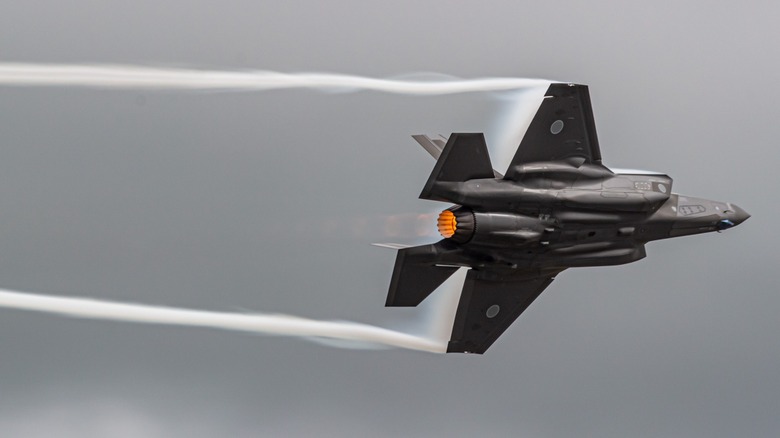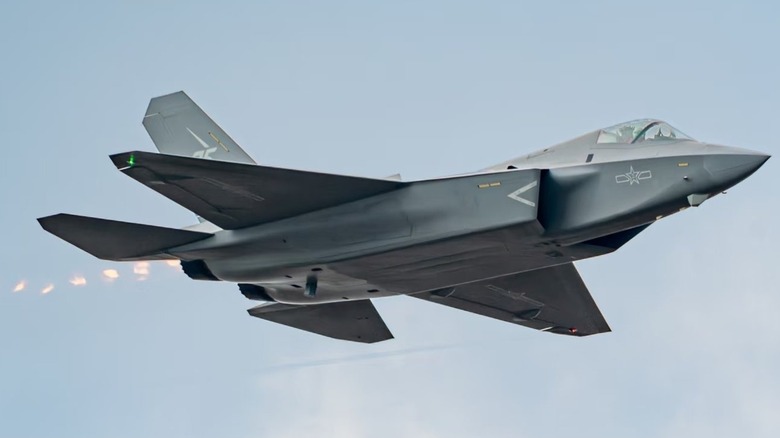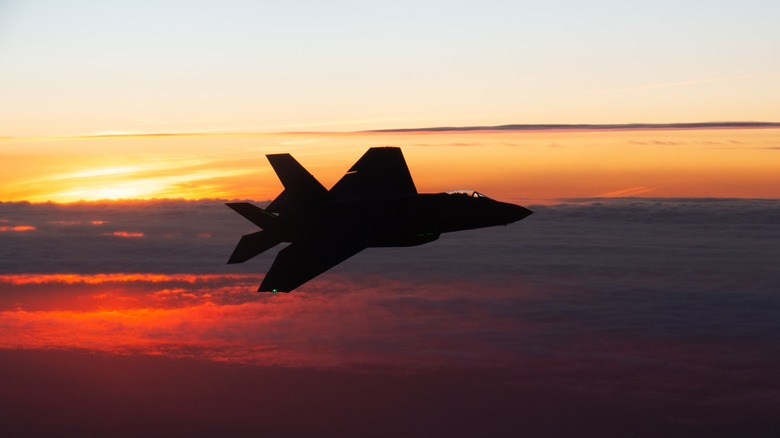F-35 Lightning II Top Speed: Here's How Fast It Is Compared To China's J-35
The United States Air Force's fifth-generation F-35 is one of the most advanced jets in the world. Debuted in 2015, Lockheed Martin's Lightning II is a powerful fighter jet with over 1 million flight hours across nearly 630,000 sorties, and is the backbone of 20 NATO and allied air forces. According to Lockheed Martin, the F-35 brings multi-utility functionality to the U.S. fleet, featuring unique connectivity capabilities that integrate the military's air, land, sea, and space operations. It even adds cyber-functionality to its patrolling of global airspace.
However, the F-35 isn't alone in vying for the title of world's best stealth jet, as China's J-35 is Beijing's answer to America's powerful fighter jet. Built by the Shenyang Aircraft Corporation, this fifth-generation fighter has been dubbed by some, including the U.S. military, as a mix of the F-35 and F-22. But Shanghai touts the People's Liberation Army Navy's second stealth fighter as surpassing its American counterpart in both stealth capabilities and overall power.
Comparing the F-35 to the J-35 is thus a useful exercise in examining the two air forces on the international stage, with the crown for the world's most lethal fighter carrying major implications for both nations' geopolitical ambitions. While total speed is a powerful metric for comparing the two aircraft, their diverse functionalities add several dimensions to a mounting technological arms race spurred, in part, by the nations' increasingly opposed geopolitical ambitions.
Top speed, climb rate, and range
Although not the first priority in its design, the F-35 stealth fighter can reach some blazing speeds. Propelled by its state-of-the-art Pratt and Whitney F135 engine, the Lightning II rockets up to Mach 1.6, or 1,200 miles per hour. While roughly only slightly higher than the F-22 Raptor's cruising speed, and substantially less than its peak at Mach 2.25, or 1,500 miles per hour, the F-35 is still incredibly powerful for an aircraft specializing in surveillance, intelligence gathering, and communication capabilities.
The climb rate of the F-35 is also impressive, reaching 45,000 feet per minute. In line with its design, the jet boasts an operational range of nearly 1,400 miles, allowing it to undertake long-distance intelligence missions without mid-air refueling. Add over 40,000 pounds of thrust while maintaining low heat signatures, and it is no wonder that some believe that the F-35 is the most advanced fifth-generation fighter in the world. Revealed at the 2024 Zhuhai Airshow, Beijing's J-35A bests its American counterpart in total velocity.
Designed to boost China's carrier operations, the J-35, nicknamed the Gyrfalcon, uses its twin WS-13E engines to blow by the F-35 with a whopping Mach 1.8, north of 1,300 miles per hour. The aircraft also delivers 25,000 pounds of thrust per engine, can reach a service ceiling of around 52,000 feet, and boasts a combat range of about 750 miles. While this last number taps out at about half the F-35's, it may not limit the jet's operational effectiveness, as the Shenyang-built craft is designed to operate from aircraft carriers.
Multipurpose stealth fighters
At first glance, the form and function of the J-35 and F-35 are strikingly similar. Both aircraft excel at reconnaissance operations, utilizing small cross-sections and radar-absorbing materials to reduce detection. Internal weapon bays further reduce the radar coverage. Their similar wing and tail designs have long been a point of controversy, with the U.S. publicly linking the coincidence to Chinese cyber espionage targeting the F-35 and F-22 programs. Others have noted, however, that these similarities could be reflective of industry-wide advancements in stealth fighter production.
Although sporting several structural design similarities, the F-35 separates itself from the J-35 with its communications and avionics systems. Its advanced sensor suite enables the F-35 to collect and distribute intelligence better than any jet of its ilk. According to Air & Space Forces Magazine, the F-35 can carry a weapons payload of 22,000 pounds. For comparison, the J-35 is believed to be capable of handling 18,000 pounds. These advantages have led some to profess that the F-35 stealth fighter is redefining dogfighting for the modern age. Despite these advantages, the F-35 program has suffered from poor mission-capable and availability rates.
According to a November 2024 Project on Government Oversight report, large maintenance backlogs, a cumbersome logistical support footprint, and poor logistics system performance have hampered the fighter's performance. The study even pointed to the fighter's inability to maintain adequate low observability signatures, a concerning reality for the most expensive weapons program in the country's history. In a time when tariffs and fraught NATO relations have some questioning the future of the F-35, Lockheed Martin suggested in May 2025 that the jet could receive a serious upgrade within the next few years, adding a sixth-generation suite that includes an expanded weapons arsenal, enhanced stealth features, and even AI-empowered unmanned pilot capabilities.


